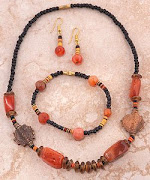African arts and crafts are very rich in form and colour and can be traced back to religious and cultural rites as long ago as 500BC. Art still forms an integral part of everyday life in Africa where it is used for communicating with ancestors and gods as well as for personal therapy. Originally African artwork had meaning – whether it was religious, cultural or a form of recording daily events and history. Today many arts and crafts are created specifically for commerce where the world has recognised the aesthetic value of the rustic, elegant creations.
We search for unique, authentic handmade African arts and crafts. We also supply original handmade African Black soap from Ghana. Based in South Africa we have a kaleidoscope of cultures and are able to select pieces from many cultures. All pieces are unique and chosen for their authenticity and appeal.
As with the Black soap, African arts and crafts have a very distinctive style which immediately sets them apart from other offerings. Being made mostly from natural materials the products have a very earthy feel and appearance and are environmentally friendly. Traditionally, materials such as bone, wood, horn, stone, gold and more recently glass are used to create magnificent artefacts. The end products – whether jewellery in the form of necklaces, armbands, and ear rings; or fabric painting are intriguing and unique. This clothe is often used to produce brightly coloured garments, or as wall decorations.
Fabric painting and Batik are vibrant and colourful, using typical traditional themes of people and animals. With oranges, browns and red predominant, these works of art lend warmth and atmosphere to any room or locale.
Although not traditional, framed African Art is becoming sort after. It retains a vibrant African flavour and often depicts the everyday way of life. Often recycled materials, such as oil cans and plastic bags, are used as a medium; or in combination with other materials to produce unique visual art. Wire art is also finding favour with street artists. This art probably stems from people with no income and no money to buy traditional art material – so they use scrap material to create artwork.




